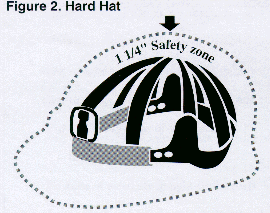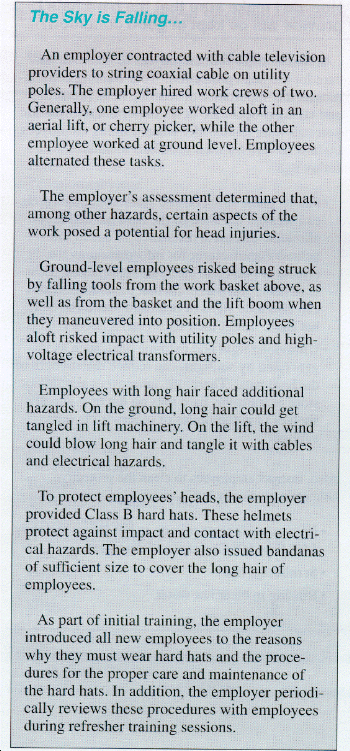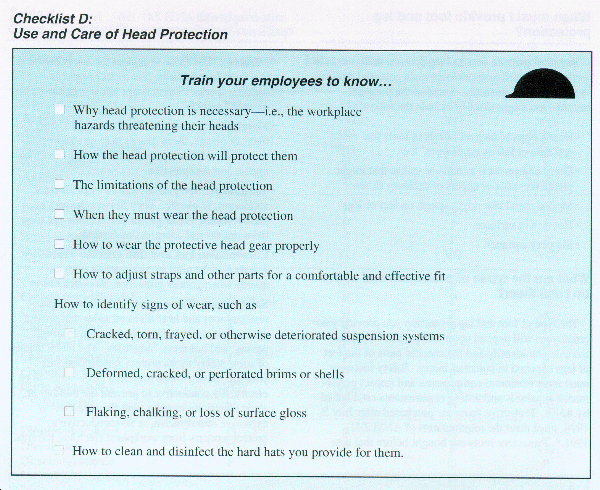
 Assessing the Need
Assessing the Need
for Personal Protective Equipment:
A Guide for Small Business Employers
Small Business Safety Management Series
U.S. Department of Labor
Occupational Safety and Health Administration
OSHA 3151
1997
When do my employees need head protection?
You must provide head protection for your employees if:
What should I look for in head protection?
In general, protective helmets, or hard hats, should
Hard hats require a hard outer shell and a shock-absorbing lining. The lining should incorporate a head band and straps that suspend the shell from 1 to 1 1/4 inches (2.54 cm to 3.18 cm) away from the user's head. This design provides shock absorption during impact and ventilation during wear.
As with devices designed to protect eyes, the design, construction, testing, and use of protective helmets must meet standards established by ANSI. Protective helmets purchased after July 5, 1994, must comply with ANSI Z89.1-1986,(7) whereas, those purchased before this date must meet the ANSI Z89.1-1969 standard.
What types of head protection are available?
Hard hats are divided into three industrial classes:
Look at the inside of any protective helmet you are considering for your employees, and you should see a label showing the manufacturer's name, the ANSI standard it meets, and its class. Figure 2 shows the basic design of hard hats.


How do I choose the correct protective helmets from among the different types?
Each kind of protective helmet is designed to protect against specific hazards. By completing the hazard assessment outlined above, you will identify the specific workplace hazards that pose a threat to your employee's head.
I have purchased new hard hats that meet the ANSI requirements. Have I fulfilled my responsibility to protect my employees' heads?
No. Issuing appropriate head protection to employees is a major first step, but you must make sure that the hard hats continue to provide sufficient protection to your employees. Do this by training your employees in the proper use and maintenance of hard hats including daily inspection of them. If your employees identify any of the following defects, remove the hard hats from service:
The suspension system shows signs of deterioration such as:
The suspension system no longer holds the shell from 1 inch to 1 1/4 inches (2.54cm - 3.18cm) away from the employee's head. The brim or shell is cracked, perforated, or deformed. The brim or shell shows signs of exposure to heat, chemicals, ultraviolet light, or other radiation. Such signs include:
Could employees wearing hard hats and working at elevations create a potential hazard for the employees working below?
To protect employees working below, you must provide chin straps for the protective helmets worn by employees working at higher elevations, whether in an aerial lift or at the edge of a pit. The chin straps should be designed to prevent the hard hats from being bumped off the employees' heads.
Can I require employees to cut their hair if it is long enough to get tangled in machinery?
Long hair (longer than four inches) can be drawn into machine parts such as chains, belts, rotating devices, suction devices, and blowers. Hair may even be drawn into machines otherwise guarded with mesh. Although you need not require your employees to cut their hair, you must require them to cover and protect their hair with bandanas, hair nets, turbans, soft caps, or the like. These items, however, must not themselves present a hazard.
Once I have selected helmets to protect my employees' heads, how do I make sure they use them properly?
Train your employees to use the hard hats. Checklist D will help you instruct your employees to use and care for the head protection you provide.
How do I make sure that the hard hats I provide will be kept in good condition?
You must train your employees to maintain and care for the head protection. Your training communicates the importance of wearing head protection and taking proper care of it. Important information you will want to consider when training employees on how to care for their hard hats includes the following:
Also, instruct employees to clean the protective helmets periodically by:
